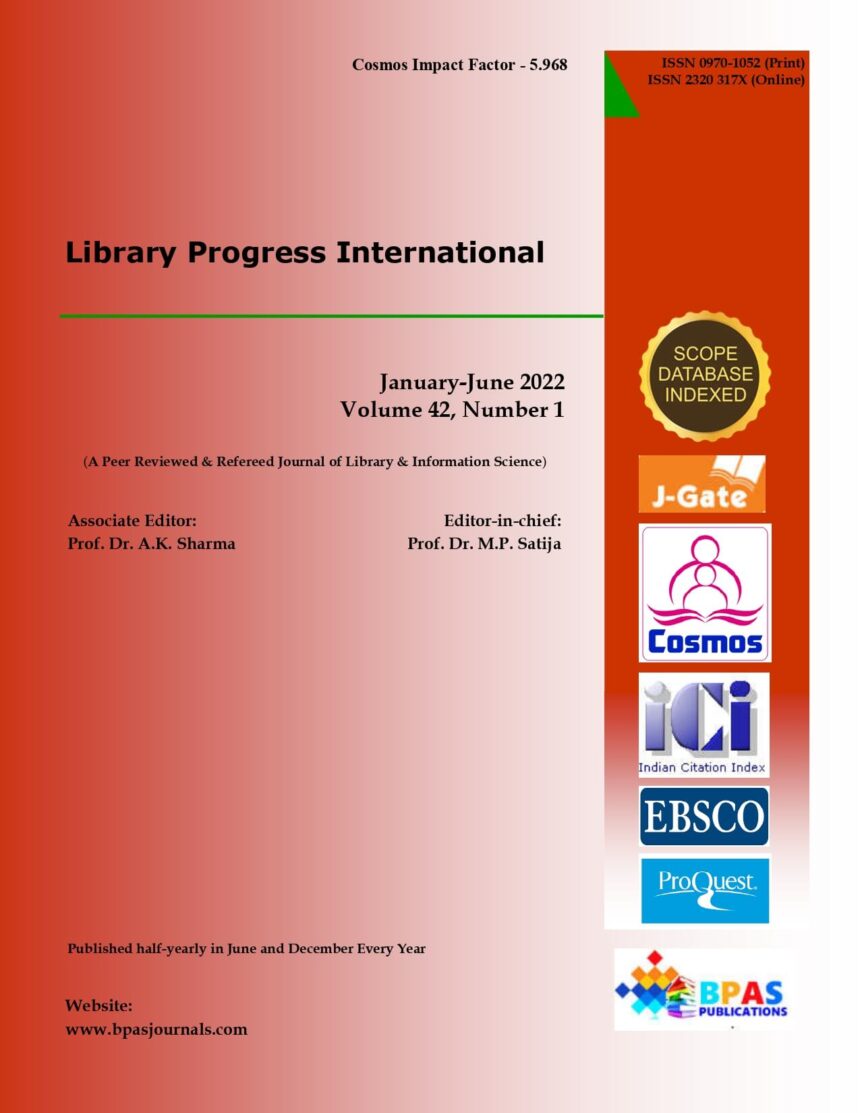Research Performance of Indian LIS Faculties from Central Universities: A Scientometric Exploration through the Lens of Web of Science (WoS)
DOI:
https://doi.org/10.48165/Keywords:
Research Growth, Research Productivity, Publication Impact, Co-authorship Pattern, Source Impact, Keyword Occurrence, Faculty’ Research Performance, LIS Faculty, Scientometrics, Web of Science, Central Universities, LIS ResearchAbstract
This study explores the research performance of LIS faculties from Central Universities of India through Web of Science using scientometric indicators. It was observed that there were 81 LIS faculties working in 17 Central Universities in India. A total of 157 unique publications were retrieved belonging to 42 LIS faculties from 14 Central Universities. BibliometrixR and VOSviewer were used for analyzing and visualization of data retrieved from WoS. Mukherjee B, of BHU, emerged as the most influential author (faculty) of LIS in terms of publications, citations, h-index and g-index. BHU was the most productive Central University in terms of LIS research. DESIDOC Journal of Library and Information Technology emerged out as the most productive source for LIS research while Scientometrics was the most cited source. “India” and its related terms were central to LIS research as observed from author’s keyword analysis.
Downloads
References
Adkins, D., & Budd, J. (2006). Scholarly productivity of U.S. LIS faculty. Library & Information Science Research, 28(3), 374–389. https://doi.org/10.1016/j.lisr.2006.03.021
Bornmann, L., & Bauer, J. (2015). Which of the world’s institutions employ the most highly cited researchers? An analysis of the data from highlycited.com. Journal of the Association for Information Science and Technology, 66(10), 2146–2148. https://doi.org/10.1002/asi.23396
Cronin, B., & Meho, L. (2006). Using the h index to rank influential information scientists. Journal of the American Society for Information Science and Technology, 57(9), 1275–1278.
https://doi.org/10.1002/asi.20354
Egghe, L. (2006). Theory and practise of the g-index. Scientometrics, 69(1), 131-152. 5. Gao, W., & Guo, H.-C. (2014). Nitrogen research at watershed scale: a bibliometric analysis during 1959–2011. Scientometrics, 99(3), 737–753. https://doi.org/10.1007/s11192-014-1240- 8
Gautam, V. K., & Mishra, R. (2015). Scholarly research trend of Banaras Hindu University during 2004-2013: A scientometric study based on Indian citation index. DESIDOC Journal of Library & Information Technology, 35(2), 75-81.
Ho, Y.-S. (2013). The top-cited research works in the Science Citation Index Expanded. Scientometrics, 94(3), 1297–1312. https://doi.org/10.1007/s11192-012-0837-
z
Huang, M., & Chi, P. (2010). A comparative analysis of the application of h-index, g-index, and a-index in institutional-level research evaluation. Journal of Library and Information Studies (JLIS), 8(2), 1–10.
Igoumenou, A., Ebmeier, K., Roberts, N., & Fazel, S. (2014). Geographic trends of scientific output and citation practices in
psychiatry. BMC Psychiatry, 14, Article no. 332. https://doi.org/10.1186/s12888- 014-0332-6
Liao, H., Tang, M., Luo, L., Li, C., Chiclana, F., & Zeng, X.-J. (2018). A bibliometric analysis and visualization of medical big data research. Sustainability, 10, 166.
Lv, P. H., Wang, G.-F., Wan, Y., Liu, J., Liu, Q., & Ma, F. (2011). Bibliometric trend analysis on global graphene research. Scientometrics, 88(2), 399–419. https://doi.org/10.1007/s11192-011-0386-
x
Meho, L. I., & Spurgin, K. M. (2005). Ranking the research productivity of library and information science faculty and schools: An evaluation of data sources and research methods. Journal of the American Society for Information Science and Technology, 56(12), 1314–1331. https://doi.org/10.1002/asi.20227
Noruzi, A. (2016). Impact Factor, h-index, i10-index and i20-index of Webology. Webology, 13(1), Editorial 21.
Onyancha, O. B., & Ocholla, D. N. (2007). Country-wise Collaborations in HIV/AIDS Research in Kenya and South Africa, 1980–2005. Libri, 57(4), 239-254. https://doi.org/10.1515/LIBR.2007.239
Oppenheim, C. (2007). Using the h-index to rank influential British researchers in information science and librarianship. Journal of the American Society for Information Science and Technology, 58(2), 297–301. https://doi.org/10.1002/asi.20460
Patra, S. K., & Chand, P. (2006). Library and information science research in India: A bibliometric study, 53(4), 219–223.
Schreiber, M. (2008). An empirical investigation of the g-index for 26 physicists in comparison with the h-index, the A-index, and the R-index. Journal of the Association for Information Science and Technology, 59(9), 1513–1522.
Shaw, D., & Vaughan, L. (2008). Publication and citation patterns among LIS faculty: Profiling a “typical professor.” Library & Information Science Research, 30(1), 47–55.
Tian, Y., Wen, C., & Hong, S. (2008). Global scientific production on GIS research by bibliometric analysis from 1997 to 2006. Journal of Informetrics, 2(1), 65–74.
Sanjay Kumar Maurya, Akhandanand Shukla, R.K. Ngurtinkhuma 21. Weller, A. C., Hurd, J. M., & Wiberley, S.
https://doi.org/10.1016/j.joi.2007.10.001 20. Tripathi, M., Kumar, S., Sonker, S. K., & Babbar, P. (2018). Occurrence of author keywords and keywords plus in social sciences and humanities research : A preliminary study. COLLNET Journal of Scientometrics and Information Management, 12(2), 215–232. https://doi.org/10.1080/09737766.2018.14 36951
E. (1999). Publication patterns of US academic librarians from 1993 to 1997. College & Research Libraries, 60(4), 352– 362.
Yazit, N., & Zainab, A. N. (2007). Publication productivity of Malaysian authors and institutions in LIS. Malaysian Journal of Library and Information Science, 12(2), 35-55. Available at https://mjlis.um.edu.my/article/view/69
/4653

